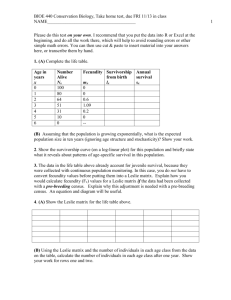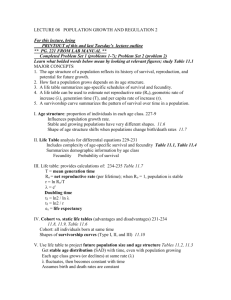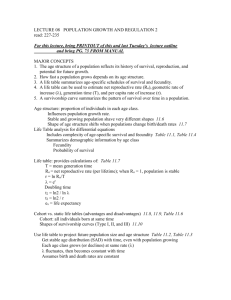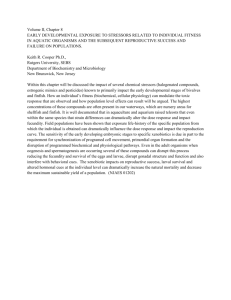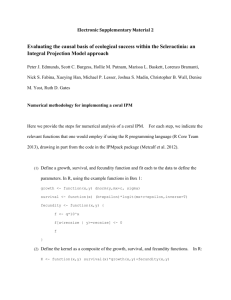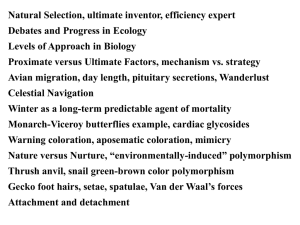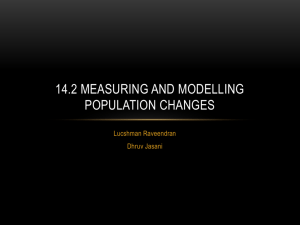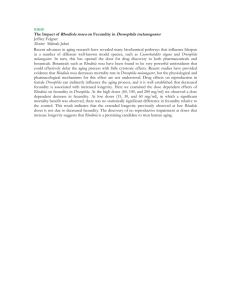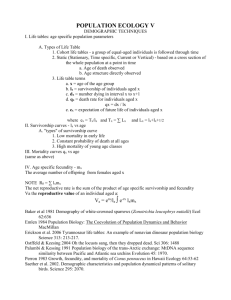Current Research Journal of Biological Sciences 3(2): 175-179, 2011 ISSN: 2041-0778
advertisement
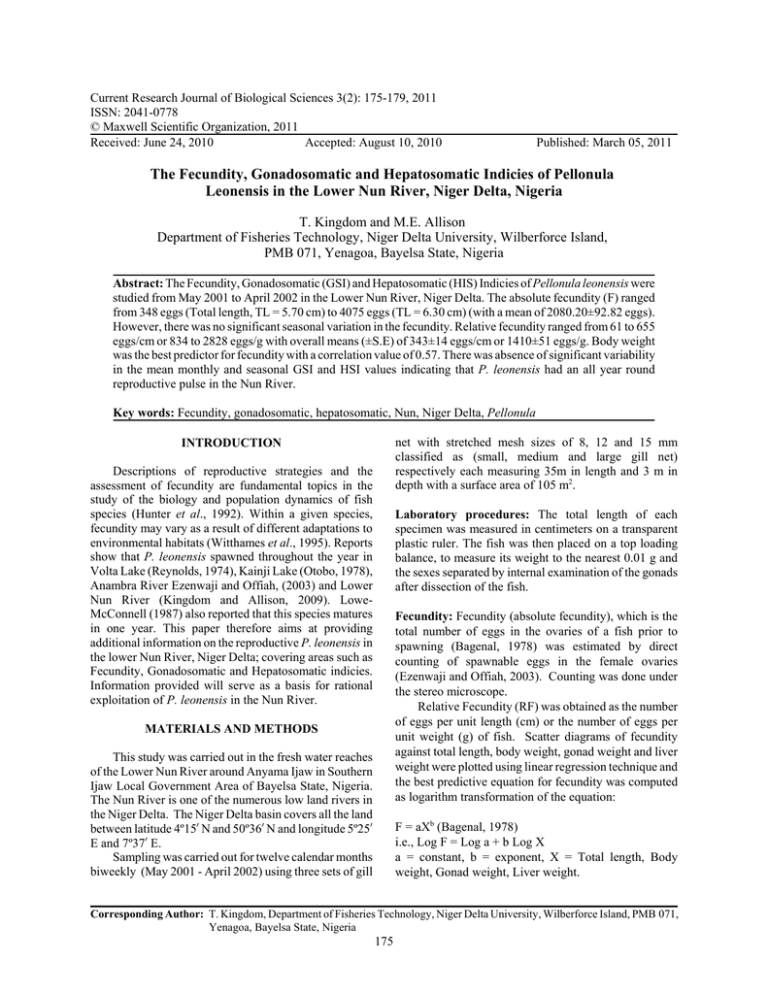
Current Research Journal of Biological Sciences 3(2): 175-179, 2011 ISSN: 2041-0778 © Maxwell Scientific Organization, 2011 Received: June 24, 2010 Accepted: August 10, 2010 Published: March 05, 2011 The Fecundity, Gonadosomatic and Hepatosomatic Indicies of Pellonula Leonensis in the Lower Nun River, Niger Delta, Nigeria T. Kingdom and M.E. Allison Department of Fisheries Technology, Niger Delta University, Wilberforce Island, PMB 071, Yenagoa, Bayelsa State, Nigeria Abstract: The Fecundity, Gonadosomatic (GSI) and Hepatosomatic (HIS) Indicies of Pellonula leonensis were studied from May 2001 to April 2002 in the Lower Nun River, Niger Delta. The absolute fecundity (F) ranged from 348 eggs (Total length, TL = 5.70 cm) to 4075 eggs (TL = 6.30 cm) (with a mean of 2080.20±92.82 eggs). However, there was no significant seasonal variation in the fecundity. Relative fecundity ranged from 61 to 655 eggs/cm or 834 to 2828 eggs/g with overall means (±S.E) of 343±14 eggs/cm or 1410±51 eggs/g. Body weight was the best predictor for fecundity with a correlation value of 0.57. There was absence of significant variability in the mean monthly and seasonal GSI and HSI values indicating that P. leonensis had an all year round reproductive pulse in the Nun River. Key words: Fecundity, gonadosomatic, hepatosomatic, Nun, Niger Delta, Pellonula net with stretched mesh sizes of 8, 12 and 15 mm classified as (small, medium and large gill net) respectively each measuring 35m in length and 3 m in depth with a surface area of 105 m2. INTRODUCTION Descriptions of reproductive strategies and the assessment of fecundity are fundamental topics in the study of the biology and population dynamics of fish species (Hunter et al., 1992). Within a given species, fecundity may vary as a result of different adaptations to environmental habitats (Witthames et al., 1995). Reports show that P. leonensis spawned throughout the year in Volta Lake (Reynolds, 1974), Kainji Lake (Otobo, 1978), Anambra River Ezenwaji and Offiah, (2003) and Lower Nun River (Kingdom and Allison, 2009). LoweMcConnell (1987) also reported that this species matures in one year. This paper therefore aims at providing additional information on the reproductive P. leonensis in the lower Nun River, Niger Delta; covering areas such as Fecundity, Gonadosomatic and Hepatosomatic indicies. Information provided will serve as a basis for rational exploitation of P. leonensis in the Nun River. Laboratory procedures: The total length of each specimen was measured in centimeters on a transparent plastic ruler. The fish was then placed on a top loading balance, to measure its weight to the nearest 0.01 g and the sexes separated by internal examination of the gonads after dissection of the fish. Fecundity: Fecundity (absolute fecundity), which is the total number of eggs in the ovaries of a fish prior to spawning (Bagenal, 1978) was estimated by direct counting of spawnable eggs in the female ovaries (Ezenwaji and Offiah, 2003). Counting was done under the stereo microscope. Relative Fecundity (RF) was obtained as the number of eggs per unit length (cm) or the number of eggs per unit weight (g) of fish. Scatter diagrams of fecundity against total length, body weight, gonad weight and liver weight were plotted using linear regression technique and the best predictive equation for fecundity was computed as logarithm transformation of the equation: MATERIALS AND METHODS This study was carried out in the fresh water reaches of the Lower Nun River around Anyama Ijaw in Southern Ijaw Local Government Area of Bayelsa State, Nigeria. The Nun River is one of the numerous low land rivers in the Niger Delta. The Niger Delta basin covers all the land between latitude 4º15! N and 50º36! N and longitude 5º25! E and 7º37! E. Sampling was carried out for twelve calendar months biweekly (May 2001 - April 2002) using three sets of gill F = aXb (Bagenal, 1978) i.e., Log F = Log a + b Log X a = constant, b = exponent, X = Total length, Body weight, Gonad weight, Liver weight. Corresponding Author: T. Kingdom, Department of Fisheries Technology, Niger Delta University, Wilberforce Island, PMB 071, Yenagoa, Bayelsa State, Nigeria 175 Curr. Res. J. Biol. Sci., 3(2): 175-179, 2011 Table 1: Monthly variation of mean fecundity and relative fecundity of P. leonensis in the Lower Nun River Relative fecundity --------------------------------------------------------------Mean egg Mean Month/Year Range Mean±S.E. Sample Size number/cm egg number/g 13 373 1435 May 2001 1158-3152 2255.69±156.03abc 16 294 1227 Jun. 898-3126 1781.86±141.02c Jul. Aug. 2 390 1688 Sept. 1626-2824 2225±599abc 4 252 1142 Oct. 1106-1994 1464.25±204.63C 4 275 1436 Nov. 1176-2022 1472±193.39C 10 347 1437 Dec. 1411-3276 2089.4±194.95bC 5 258 1321 Jan. 2002 1192-1898 1439.6±121.78C 11 496 1952 Feb. 1960-4075 3087.36±227.15a 11 272 1044 Mar. 348-3864 1671.64±330.18C 5 436 1460 Apr. 2294-3916 2804.8±288.7ab Season Dry season 348-4075 2048.62±142.72 45 317 1389 Wet season 899-3916 2119.67±110.53 36 373 1453 Overall 348-4075 2080.20±92.82 81 343±14 1410±51 Different letters (a,b,c,d) in the same column indicate significance (p<0.0001) eggs/g with overall means (±S.E) of 343±14 eggs/cm or 1410±51 eggs/g (Table 1). Fecundity - total length, fecundity - body weight, fecundity - gonad weight and fecundity - liver weight relationships of P. leonensis in the Lower Nun River are shown in Fig. 1, 2, 3 and 4, respectively. The relationships of this population expressed in linear regression equation are as follows: Gonadosomatic Index (GSI): The Gonadosomatic Index (GSI) was determined (King, 1995) as: GSI = 100 (Gm/Tm) where; Gm = Mass of Gonad Tm = Total mass of fish Hepatosomatic Index (HSI): The HSI was determined (Htun-hun, 1978) as: F = -10.44 TL 2.90 (p<0.001; r = 0.54) F = 1333.40 BW 0.95 (p<0.001; r = 0.57) F = 2103.25 GW 0.05 (p<0.05; r = 0.09) F = 4113.49 LW 0.17 (p<0.001; r = 0.23) HSI = liver weight x 100 Body weight The correlations were positive but low; body weight had a better predictive value of 0.57 than total length (0.54) gonad weight (0.06) and liver weight (0.23) Mean monthly values were computed and plotted to ascertain monthly variations. Means were also computed for size classes and test of significant differences between males and females tested. Gonadosomatic Index (GSI): GSI values are shown in Fig. 5. There was no significant variation (p>0.05) in the mean GSI values between male (3.82±1.62) and female (7.33±0.70) of P. leonensis. The highest GSI values were attained in February for combined sex while the lowest values were recorded in July. However, there was no significant variation (p>0.05) in monthly and seasonal GSI means. Also, there was no significant difference (p>0.05) in the mean GSI value of different class sizes (Table 2). RESULTS The range, mean monthly and seasonal fecundity are given in Table 1. The mean monthly fecundity showed four seasonal peaks. The highest mean absolute fecundity of 3087.36±227.15 eggs was recorded in February. The other peaks were observed in April (2804.8±288.87 eggs), May (2255.69±156.03 eggs), September (2225±599 eggs) and December (2089.4±194.95 eggs). But the overall fecundity of P. leonensis ranged from 348 eggs (Total length, TL = 5.70 cm) to 4075 eggs (TL = 6.30 cm) (with a mean of 2080.20±92.82 eggs). However, there was no significant seasonal variation in the fecundity. Relative fecundity ranged from 61 to 655 eggs/cm or 834 to 2828 Heptosomatic Index (HSI): HSI values are shown in Figure 6. There was no significant difference (p>0.05) in the mean HSI values between male (1.14±0.78) and female (0.87±0.04). The highest HSI values were obtained 176 Curr. Res. J. Biol. Sci., 3(2): 175-179, 2011 Fecundity 3.7 3.4 3.1 F=10.44TL2.90 r=0.54 2.8 2.5 0.62 0.64 0.66 0.68 0.7 0.72 0.74 0.76 0.78 0.8 0.82 0.84 0.86 0.88 0.9 0.92 Total length Fig. 1: Relationship between fecundity total length of P.leonensis in the lower Nun River 3.7 F=1333.40BW 0.95 r=0.57 Fecundity 3.4 3.1 2.8 2.5 -2 -1 0 1 Body weight Fig. 2: Relationship between fecundity and body weight of P. leonensis in the lower Nun water 3.7 F=2103.25GW 0.05 R=0.06 Fecundity 3.4 3.1 2.8 2.5 -3 -2 -1 Gonad weight 0 1 Fig. 3: Relationship between fecundity and gonad weight of P. leonensis in the lower Nun water 1978) for P. leonensis (140 to 4,900 eggs) in Kainji Lake but different from the range given by Balogun (1987) (6,322-30,623 eggs) in Lagos lagoon and Ikomi (1993) (9,567-16,235 eggs) in Warri River. However, the mean absolute fecundity obtained here is close to the 2,000 relatively large eggs reported by Reynolds (1969) but different from the 896±477 eggs estimated by Ezenwaji and Offiah (2003) and 13,635 eggs by Balogun (1987) in Anambra River and Lagos Lagoon, respectively. The observed low correlations of the fecundity - total length and fecundity - gonad weight correspond well with in February (5.07±4.18) for combined sex while the lowest values were recorded in September (0.19±0.10). However, there was no significant variation (p>0.05) in the monthly and seasonal HSI values as well as the mean HSI values of different class sizes (Table 3). DISCUSSION In this study, the range of absolute fecundity of 348 eggs (Total length, TL = 5.70 cm) to 4, 075 eggs (TL = 6.30 cm) agrees with the range reported by Otobo (1977, 177 Curr. Res. J. Biol. Sci., 3(2): 175-179, 2011 3.7 Fecundity 3.4 3.1 2.8 2.5 -3 -2.8 -2.6 -2.4 -2.2 -2 -1.8 -1.6 -1.4 -1.2 Fig. 4: Relationship between fecundity and liver weight of P. leonensis in the lower Nun water GSI 15 10 5 0 May-01 Jun Jul Aug Sept Oct Nov Dec Jan-02 Feb Mar Apr Months HIS Fig. 5: Mean monthly gonadosomatic index (GSI) of P.leonensis in the lower Nun River 6 5 4 3 2 1 0 May-01 Jun Jul Aug Sept Oct Nov Dec Jan-02 Feb Mar Apr Months Fig. 6: Mean monthly hepatosomatic index (HSI) of P.leonensis in the lower Nun River Table 2: Mean GSI values of different size classes of P. leonensis in the lower Nun River Size class Range GSI Mean+S.E. Sample Size (n) 3.5-4.5 0.18-1.63 0.89±0.17 9 4.5-5.5 0.04-384.62 5.47±2.65 145 5.5-6.5 0.17-83.68 5.30±0.58 203 6.5-7.5 0.15-38.17 6.15±1.17 35 7.5-8.5 0.17-3.41 1.70±0.40 9 8.5-9.5* 1 *: Sample with < 2 specimens were not included in analysis weight relationship is the only one available on this species. In the exponential formula linking fecundity to total length, the exponent ‘b’, with the numerical value 2.90 obtained for the lower Nun River population of P. leonensis, is within the range 2.3-5.3 calculated for a variety of species by Bagenal (1978). However, the value is higher than the 1.82 calculated for the P. leonensis population of Anambra River (Ezenwaji and Offiah, 2003) Table 3: Mean HSI values of different size classes of P. leonensis in the lower Nun River Size class HSI Mean ± S. E. Sample Size (n) Range 3.5-4.5 0.43±0.11 9 0.17-1.06 4.5-5.5 1.74±1.27 145 0-184.62 5.5-6.5 0.62±0.04 203 0.58-2.56 6.5-7.5 0.69±0.08 35 0.11-1.85 7.5- 8.5 0.69±0.10 9 0.34-1.18 8.5- 9.5* 1 *: Sample with < 2 specimens were not included in analysis. GSI and HIS: The absence of significant variability in the mean monthly and seasonal GSI and HSI values confirm the fact that P. leonensis has an all year round reproductive pulse. This was also the observation of Ezenwaji and Offiah (2003) in their study of Anambra River. CONCLUSION the earlier findings of Ezenwaji and Offiah (2003) for this species in Anambra River but the best predictor of fecundity observed in this study is contrary to the total length they reported. The result on fecundity - liver P. leonensis has an all year round reproductive pulse with a mean fecundity of 2080±92.82 eggs while body weight was the best predictor of fecundity in the Lower Nun river populations. 178 Curr. Res. J. Biol. Sci., 3(2): 175-179, 2011 King, M., 1995. Fisheries Biology Assessment and Management. Fishing News Books Blackwell Science Ltd., London, pp: 341. Kingdom, T. and M.E. Allison, 2009. Aspects of the Reproductive Biology of Pellonula leonensis in the Lower Nun River, Niger Delta. Curr. Res. J. Biol., Sci., 1(3): 68-71. Lowe-McConnell, R.H., 1987. Ecological Studies in Tropical Fish Communities. Cambridge University Press, pp: 382. Otobo, F.O., 1977. The Biology of the Clupeid fishes in Lake Kainji, Nigeria. Ph.D. Thesis, University of Ife, Ile-Ife, Nigeria, pp: 272. Otobo, F.O., 1978. The reproduction biology of Pellonula afzeliusi Johnels, and Sierrathrissa leonensis thys Audenaerde in Lake Kainji, Nigeria. Hydrobiologia, 61(2): 99-112. Reynolds, J.D., 1969. The Biology of Clupeids in the New Volta Lake. In: Obengi, L.E. (Ed.), Man-made lakes: The Accra Symposium. Ghana University Press Accra, pp: 195-203. Reynolds, J.D., 1974. Biology of the small Pelagic fishes in the New Volta Lake in Ghana. Part III. Sex and reproduction. Hydrobiogia, 45: 489-508. Witthames, P.R., M. Greer, M. Walter, T. Dinis and C.L. Whitting, 1995. The Geographical variation in the potential annual fecundity of Dover Sole, Solea solea, from European Shelf waters during 1991. Neth. J. Sea. Res., 34: 45-58. ACKNOWLEDGMENT We sincerely thank Mr. Hanson Uyi for his assistance in identifying specimens and providing keys. REFERENCES Bagenal, T.B., 1978. Aspects of Fish Fecundity. In: Gerking, S.D. (Ed.), Ecology of Freshwater Fish Production. Blackwell Scientific Publications, Oxford, pp: 75-101. Balogun, J.K., 1987. Studies on some aspects of the Biology of Pellonula afzeliusi (Johnels) in Epe Lagoon, Nigeria. Arch. Hydrobiol., 109(4): 517-530. Ezenwaji, H.M.G. and F.N. Offiah, 2003. The Biology of Pellonula leonensis Boulenger, 1916 (Osteichthyes: Clupeidae) in Anambra River, Niger. Bio-Res., 1(2): 33-50. Htun-han, M., 1978. The reproductive biology of the dab Limanda limanda (L) in the North Sea; gonadosomatic Index; Hepatosomatic Index and condition factor. J. Fish Biol., 13: 369-378. Hunter, J.R., B.J. Macewicz, N.C.H. Lo and C.A. Kimbrell, 1992. Fecundity, spawning and maturity of female Dover Sole, Microstomus pacificus, with an evaluation of assumptions and precision. Fish. Bull., U.S., 90: 101-128. Ikomi, R.B., 1993. Studies on the ecology of the clupeid (Pellonula leonensis Regan, 1917) in the River Warri (Niger Delta, Nigeria). Acta Hydrobiol., 35: 381-398. 179
